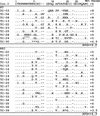High frequency of syncytium-inducing and CXCR4-tropic viruses among human immunodeficiency virus type 1 subtype C-infected patients receiving antiretroviral treatment
- PMID: 12805470
- PMCID: PMC164829
- DOI: 10.1128/jvi.77.13.7682-7688.2003
High frequency of syncytium-inducing and CXCR4-tropic viruses among human immunodeficiency virus type 1 subtype C-infected patients receiving antiretroviral treatment
Abstract
Human immunodeficiency virus type 1 (HIV-1) subtype C viruses have been found to almost exclusively use the chemokine receptor CCR5 as a coreceptor for entry, even in patients with advanced AIDS. We have characterized subtype C virus isolates from 28 patients from Harare, Zimbabwe, 20 of whom were receiving antiretroviral treatment. Virus from 10 of the treated patients induced syncytium formation (SI virus) when cultured with MT2 cells. Only non-syncytium-inducing (NSI) virus was cultured from the peripheral blood mononuclear cells of the eight patients who had not received treatment. The majority of these subtype C SI viruses were capable of using both CCR5 and CXCR4 as coreceptors for viral entry, and the consensus V3 loop sequences from the SI viruses displayed a high net charge compared to those of NSI viruses. While those on treatment had reverse transcriptase (RT) and protease mutations, there was no clear association between RT and protease drug resistance mutations and coreceptor tropism. These results suggest that CXCR4-tropic viruses are present within the quasispecies of patients infected with subtype C virus and that antiretroviral treatment may create an environment for the emergence of CXCR4 tropism.
Figures


References
-
- Bjorndal, A., A. Sonnerborg, C. Tscherning, J. Albert, and E. M. Fenyo. 1999. Phenotypic characteristics of human immunodeficiency virus type 1 subtype C isolates of Ethiopian AIDS patients. AIDS Res. Hum. Retrovir. 15:647-653. - PubMed
-
- Cecilia, D., S. S. Kulkarni, S. P. Tripathy, R. R. Gangakhedkar, R. S. Paranjape, and D. A. Gadkari. 2000. Absence of coreceptor switch with disease progression in human immunodeficiency virus infections in India. Virology 271:253-258. - PubMed
Publication types
MeSH terms
Substances
Associated data
- Actions
- Actions
- Actions
- Actions
- Actions
- Actions
- Actions
- Actions
- Actions
- Actions
- Actions
- Actions
- Actions
- Actions
- Actions
- Actions
- Actions
- Actions
- Actions
- Actions
- Actions
- Actions
- Actions
LinkOut - more resources
Full Text Sources
Other Literature Sources
Medical
Molecular Biology Databases

